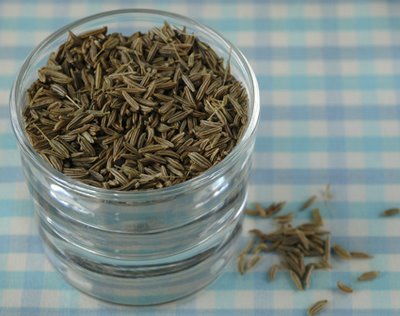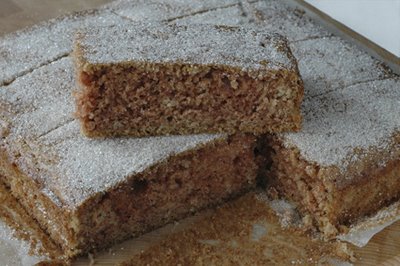
Just in time for your harvest supper...
Seed cake is a plain sponge flavoured with caraway seeds, and maybe including some mixed peel. The taste for caraway seeds is perhaps out of fashion now (in the UK at least), but they were once a flavouring much used in cakes, breads, buns and biscuits from the 17th century to the mid-20th.

I have also found that 'seed cake' can be used as a more general term for a cake served at festivals to celebrate the spring sowing of wheat, or to celebrate the autumn harvesting of the crop. Laura Mason writing in the 'Oxford Companion to Food', quotes from a book published in 1892: "Fifty years ago seed-time also had its festival, although on a lesser scale, as well as harvest. At the backend, when the early sowing had been completed, the farmer made a sort of feast for the men, the principle feature of which was 'seed-cake', which was given to each of them. The cake did not get its name from anything that it contains, for in was in fact an ordinary sort of currant or plum cake, but from the occasion." Elizabeth David in 'English Bread' suggests that the caraway seeds were symbolic of the wheat grains sown, and that this would also explain the inclusion of such cakes and breads on the Lenten table (I assume she means eaten to celebrate the end of Lent). One sweetened bread product that included caraway seeds was the wigg - these were eaten with ale and cheese at harvest time, but over time also became a richer, grander bun. For more information on harvest traditions, click here.
Harvest festivals and harvest suppers are traditionally held on the Sunday nearest to the Autumn Equinox (when the hours of daylight equal the hours of darkness). This year the Autumn Equinox is the 23rd of September, i.e. yesterday (and the official start of autumn, nights drawing in etc., but let's not think about that aspect of the season).
Although during my research I came across references to seed cake (all of the caraway variety) made in different regions of the country. The recipes varied very little - some cakes had mixed peel or lemon zest in them, others had solely caraway seeds. I think that seed cake had wide popularity and was baked nationwide, so cannot be attributed to any particular corner of the country.
I have baked seed cake previously from a recipe in Waitrose Food Illustrated magazine. This made a cake similar to madeira cake in buttery richness, and I loved the flavour that the seeds gave to what otherwise would be a very plain cake. I decided to try another recipe this time round, and settled on one from Jane Grigson's ' English Food'. The difference with this recipe is that it includes a small amount of ground almonds, which Jane claims makes the cake 'moist and delicious and most exceptional'! Elizabeth David, not a fan of caraway, had been put off seed cake by dry sponges eaten as a child, and I suspect Jane Grigson may have had similar experiences, hence her delight at finding a recipe resulting in a moist cake.
175g butter
175g caster sugar
3 eggs
1 rounded dessertspoon of caraway seeds
1 level tablespoon ground almonds
250g self-raising flour
A little milk on stand-by
1. Preheat oven to 180C/350F/Gas 4. Prepare a loaf tin.
2. In a large bowl cream together the butter and the sugar. When mix is light and fluffy stir in the caraway seeds.
3. Sift the flour into another bowl and stir in the almonds.
4. Separate the eggs. Whisk the egg whites until stiff, but not too dry looking (you're not making meringues here). In another bowl beat together the yolks. Fold the yolks into the whites.
5. Add a little of the egg mix to the creamed butter and sugar, and a little of the flour. Stir in carefully. Continue to do this until all is blended. If the resulting mixture looks a little dry, add a little milk (I put in about 3 tablepsoons worth).
6. Put cake mixture into the prepared tin, and level the top with the back of a spoon.
7. Bake for about an hour and 5 minutes.
8. Allow cake to cool in tin for 20 minutes before turning out on to cooling rack.

Following a suggestion of my husband's (well, you have to once in a while) I iced the cake with glace icing, but I couldn't help but slip in a little lemon juice so that it had a good citrus kick. I had wanted to use some lemon zest in the cake, so figured that lemon in the icing was a good second option. Actually I felt the that lemon flavour was perhaps too strong ( I used a whole lemon), but it made a good contrast to the flavour of the sponge. The sponge was nice and moist, but I am not sure that the small quantity of ground almonds would make that much difference. The recipe that I have used before didn't contain almonds, and this cake turned out equally well.
A slice of seed cake is good with a glass of madeira, or, equally, a good old-fashioned cup of tea. Here's to autumn - flaming leaves; conkers; hot chocolate on a cold evening; home-made soup for lunch and toad-in-the-hole for tea!




